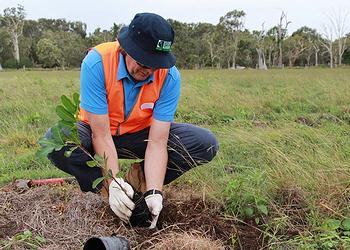
LONDON, UK, November 28, 2017 (ENS) – Three of world’s largest conservation organizations – BirdLife International, the Wildlife Conservation Society and WWF – have just launched an unprecedented 25-year tree planting and restoration effort they are calling the Trillion Trees program.
Roughly half of the world’s original six trillion trees have been lost since the beginning of civilization.
Most of the remaining forests have been damaged by industrial-scale human activities. Yet, they still hold more than 45 percent of the terrestrial carbon, are home to two-thirds of all land-based plants and animals, and support the livelihoods of 1.6 billion people.

The partner groups say one trillion is the number of new trees needed to reverse the global decline in tree cover.
Their vision is that by mid-century, through concerted collective action by all sectors of society, one trillion trees have been planted.
By 2050, they envision that deforestation has ended, significant numbers of trees have returned to areas where they were lost and large areas of existing trees are better protected.
Trillion Trees was initiated by Restore UK, established in 2001 as a grant-making charity to invest in the protection and restoration of Britain’s natural habitat. This vision has since expanded to incorporate environmental and biodiversity issues around the world.
The planet is losing 10 billion trees every year, leading to widespread impacts on biodiversity, carbon sequestration, local economies and human health, the groups warn.
The response of the Trillion Trees partnership is twofold: catalyze large-scale investments to protect, restore, and replant trees in the most at-risk landscapes; and inspire greater action under private and public forest commitments.

“It’s about the right trees in the right places,” said Patricia Zurita, CEO of BirdLife International.
“With responsible land use comprising almost 25 percent of the global climate solution, aligning our forest work through Trillion Trees is our contribution to one of the largest societal priorities of the 21st century,” said Zurita.
“Combatting forest loss and increasing forest restoration are central to meeting some of the world’s most important environmental goals,” she said, “and BirdLife is thrilled to be part of this important effort.”
The tree-planting partners are guided by the Paris Climate Agreement, the New York Declaration on Forests, and the UN Convention on Biodiversity.
Their policy goals include the Bonn Challenge to restore 350 million hectares of forests by 2030, the Convention on Biological Diversity’s Aichi Targets, which aim to halve forest loss by 2020, and the New York Declaration on Forests, which aims to end deforestation by 2030 and reinforces the Bonn Challenge restoration goal.
The partner groups, which collectively work in more than 120 countries, say they will create “tailored solutions,” mainly involving “corporate actors.”
Their focus is on corporations because they say corporate commodity supply chains are linked to 80 percent of the loss of tropical forests across Asia, South America, and Sub-Saharan Africa, the very areas that are most crucial to absorbing global greenhouse gases.
Wildlife Conservation Society Chief Conservation Officer John Robinson said, “Many companies and governments already recognize the value that trees hold for human societies and wildlife, which is why so many are committing themselves to zero-deforestation policies.
All three of the groups are already jointly advancing some of these activities in high-priority forests, particularly forests from which palm, soy, beef, and timber products originate.
The partners will use a combination of better forest regulations and protections, assisted natural regeneration, and the replanting of trees to develop successful “proof-of-concept” projects that are fundable and that effectively increase tree cover.
Projects under development include:
* – Supporting long-term financing, expansion and strengthening of the protected areas network in Colombia
* – Scaling up environmental certification in locally controlled forests in Tanzania
* – Supporting the design and financing of large-scale restoration plans for vulnerable watershed areas of the Rwandan highlands
* – Establishing sustainable, deforestation-free models of cocoa production linked to protection of adjacent forests in multiple landscapes in Africa and elsewhere.
“Although forest restoration plans and strategies to avoid deforestation exist around the world, on-the-ground implementation and financing of these commitments lag well behind these ambitions,” said Simon Petley, forest and finance program manager, WWF-UK.
“Trillion Trees will help achieve global forest commitments by bringing together a diverse group of corporate, non-profit, and community stakeholders to deliver targeted conservation projects and unlock access to private-public funding,” said Petley.
Trillion Trees has received generous seed funding from UK-based funders Restore-UK to help conserve the world’s most at-risk trees from further loss and restore critical ones that have already disappeared.
In the coming years, the Trillion Trees partners will expand these initial activities and mobilize financing for other priority areas for solutions that account for local forestry and related social and economic issues.
Copyright Environment News Service (ENS) 2017. All rights reserved.
© 2017, Environment News Service. All rights reserved. Content may be quoted only with proper attribution and a direct link to the original article. Full reproduction is prohibited.
